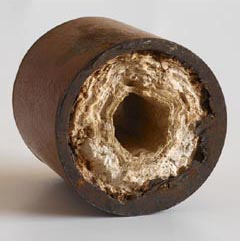In this presentation, Gary Klein shares important information about air source heat pump water heaters (HPWH), with particular attention paid to where the warm air comes ...
Boiler Failure After Two Years

The boilers (and there were 20 of them) were laying out there in the parking lot, not far from the boiler room door. I could see them as Joe and I drove up. “Nobody knows what happened,” he said. “All twenty of them cracked, and they’re only two years old.”
We walked over for a closer look. They were Hydrotherms, little boilers that had worked together in a modular setup to get a big job done. I looked up at the four-story apartment building. “It’s for seniors,” Joe said. “That’s why they went with the modular boilers. They stage-fire the boilers, which is nice because they can track the weather. And they also have that built-in standby capability. Or at least they thought they did. Who would ever believe that all twenty boilers would crap out at the same time?”
I looked at the boilers. Some of them had holes through which you could have tossed a ferret. Others had sections snapped right off. Strange colors, too. They looked like they had been dipped in hell.
“The crazy thing is, the contractor just reinstalled new boilers. No one knows what happened to these, but they put in new ones anyway. So the old folks could have heat.”
“Who looked at the job?” I asked.
“Everybody,” Joe said. “The engineer, the contractor, the boiler rep, the pump people. Everybody with a hand in the job.”
“What did they say?” I asked.
“That it was just one of those things,” Joe said.
“Twenty boilers die on the same day and it’s just one of those things?”
“Good enough answer when you don’t have a better one,” Joe said.
I looked inside one of the sections. It was coated with what looked like cement. “Have you seen this?” I asked. Joe nodded. “It’s lime,” I said.
“I know,” Joe said. “The water in this area is very hard. The lime forms on everything. Wait ‘til you see the valve stems. They’re covered with the stuff.”
So we went inside and looked around. Joe was right; there was very hard water in this part of the state. It looked like Howe Caverns in there. Dozens of hydronic stalactites hung from the valves.
Joe and I talked it over and came to the conclusion that someone had been adding a bodacious amount of fresh water to this system. It couldn’t be anything else.
By this time, Carlos, the superintendent, had joined us. I happen to love superintendents because they will always give you the clues to what went wrong. They know what happened, but they don’t know that they know. Many times, troubleshooters, especially those from the manufacturers, won’t talk to the superintendents because those guys don’t seem important. They are, though. They’ve got the clues.
“Carlos,” I said, “did someone add a lot of water to this heating system?”
“I don’t think so,” he said.
“Let me put it another way,” I said. “Did a lot of water come out of this heating system? It’s okay to tell me. You’re not in trouble or anything. I just need to know if you used a hose from the boiler to melt snow or wash cars or something like that.”
“No,” he said. “Not me.”
I pointed to one of the many relief valves on the job. “Did you ever see water coming out of these things?”
“Oh, yes!” he said.
“When?”
“Two years ago. When new. In the fall. Then everything fine in the winter. Then again in the spring. Big mess on the floor.”
“And what did you do?” I asked.
“I mop. And I tell the boss, and he put these pipes.” Carlos points to the pipes that run from the boiler relief valves to the floor drain. “No more mess!,” he says.
“But they still shoot water?” I asked.
“Only in the fall and in the spring. In the winter, everything is good.”
See what I mean about superintendents? Those guys are beautiful.
“So the relief valves were popping, and the feed valve was open,” I said to Joe.
“That explains the lime in the boilers,” Joe said. “Bad compression tank, you think?”
“Could be, but that wouldn’t explain why the relief valves popped in the fall and the spring but not in the winter. If it were the tank, it would be happening all the time. Must be something else.”
That’s when we decided to think like water. If we were water, what would we do? Where would we go? How would we work our way around this system? And what would make us want to leave by way of the relief valve?
We checked the boiler’s fill pressure. It was 28 psi. The relief valves were set to pop at 50 psi. So far, so good. We looked at the circulators – two vertical inline beasts, each capable of pounding out about 80 feet of pump head. We took a walk around the building. There were hundreds of radiators, and each had a thermostatic radiator valve. We went back to the boiler room.
“I still think it’s bizarre that they put in the new boilers before figuring out what had gone wrong,” I said.
“Just one of those things,” Joe said with a smile. “Something like this happens, everyone starts pointing the finger at the other guy. Meanwhile, the building just wants to get the heat back on. The insurance company pays up and the stuff goes right back in. It’s an emergency.”
“Just one of those things,” I said. And we poked around the boiler room some more. And that’s when we spotted the bypass valve. It was up high, between the main supply and return lines. It was just a motorized two-way valve, and it had two operational choices: open or closed. We traced the wiring over to a pressure-operated switch in the main supply line. When the pressure got to a certain point, the two-way valve would open, allowing the water to flow back to the boilers. “That’s there for when the thermostatic radiator valves are closed,” I said. “The water needs a place to go because the TRVs can’t talk to the pumps. The pump backs up on its performance curve. The pressure switch senses it, and opens the valve. The pumps now have access to the butt end of the boilers.”
“And the TRVs are going to be closed more often in the spring and the fall than they are in the dead of winter,” Joe said.
“Right. And when that two-way valve opens, eighty feet of pump head, or about thirty-five psi, hits the boilers.”
“Which are already seeing twenty-eight pounds of static head pressure,” Joe said.
“And that makes the total pressure sixty-three psi.”
“On fifty-psi relief valves!” Joe said, and he smiled. Problem solved.
It’s not just one of those things. Not at all. It never is when it’s mechanical. There’s always a reason for things.
This job should have had a differential-pressure regulator, since that sort of valve can mimic the pressure drop of the full system piping when the water is bypassing to the boiler return. The two-way valve couldn’t gobble up the excess pressure, so it popped the relief valves, and cost the building 20 boilers within the first two years.
We solved this one with the lowest-cost solution. We had the contractor install 75-psi relief valves on the boilers. The pump couldn’t pop those. Everything in the system could take the higher pressure, and like I said, it was cheap. The building liked that. Cheap.
Just one of those things.
Leave a comment
Related Posts

In this all-technical three-hour seminar, Dan Holohan will give you a Liberal Arts education in those Classic Hydronics systems. He’ll have you seeing inside the pipes as...
We always have turkey for Thanksgiving. I mean who doesn’t? My job wasn’t to cook it, though; it was to eat it.